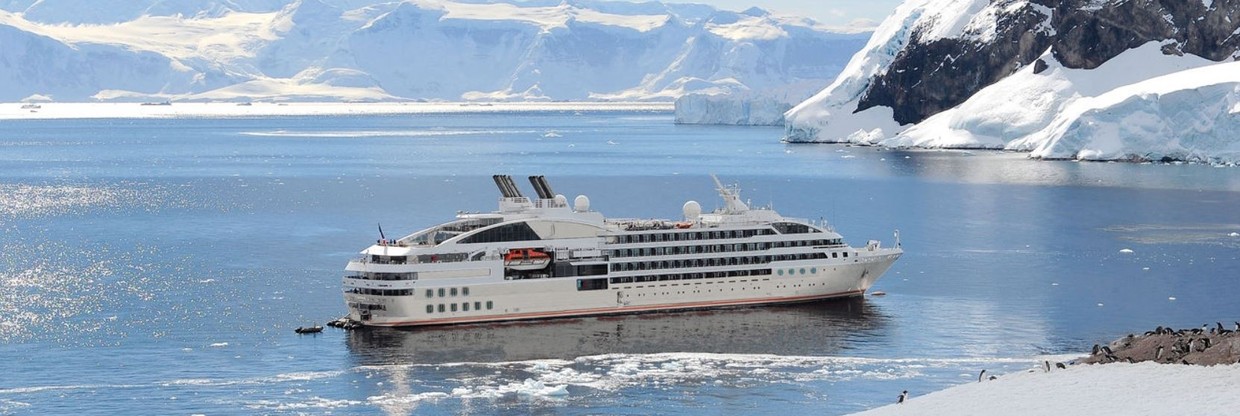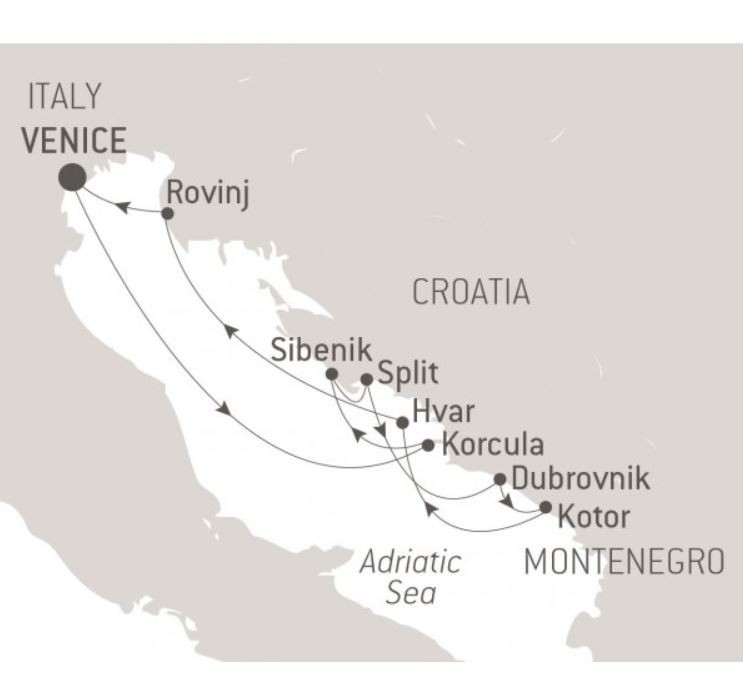2019-10-11
2025-01-01
Note: Current p/p indicative rate. Final price may change due to currency fluctuations.
From Venice, we set sail for Croatia and its many hidden treasures. Le Lyrial slips effortlessly through the turquoise Adriatic Sea, wending her way between necklaces of islands dotted here and there off the Dalmatian Coast. There are cities which thrive on their legend and Venice, the City of Doges is one of these with its many offshoots lined with multi-colored stonework and its black gondolas. If Dubrovnik is the Pearl of the Adriatic, Split is its beating heart. A UNESCO World Heritage site, The centre of Split is built into the remains of Emperor Diocletian's Palace and now mixes the ancient remains of thermal baths, alleyways and courtyards with restaurants, cafes and shops. Kotor Bay is known as the largest Fjord in the Mediterranean (strictly speaking it is a ria, a flooded river valley, not a fjord) and its dramatic steep sides maintain a peaceful calm over the waters, studded with tiny islands (see below). On our way back to Venice, we stop at Hvar, known as one of the Adriatic's most beautiful islands, and Pula and Rovinj, Croatia's Riviera. The beauty of small ship cruising is that the luxurious Lyrial can get to places that the large liners cannot, without foregoing any of life's creature comforts.
Proud and eternal, Venice has reigned on its lagoon ever since the 6th century. You may think you know this city before even setting foot here. You will inevitably fall in love with the charm of the innumerable treasures of the Serenissima: Saint Mark’s square, the basilica, Doges palace, the Grand Canal and the gondolas. Yet, secret Venice is also waiting for you to explore its little interlacing streets and canals, to ramble through its squares and to push open the doors of its churches. The city’s extraordinary heritage shouldn’t stop you from enjoying a glass of Spritz and a few tramezzini.
This harbour town has a very special location, presiding on a spur on the north-eastern coast of the island of Kor?ula. The ramparts in its medieval district provide perfect vantage points over the Pelješac peninsula. To get there, you can take the monumental staircase in the Revelin Tower.Another way is to climb the steps in the shade of palm trees from the MorskaVrata (Marine portal). As you make your way through the little streets, you’ll see the bell-tower of Saint-Mark’s cathedral rise above you. This landmark will help you locate the house where Marco Polo was born. The island also has some of its own famous wines like the red Plavac and the white Posip.
Šibenik is one of the oldest capitals in Croatia. It is located on the Dalmatian coast, at the mouth of the Krka river. On the Dalmatian coast, the town of Split offers cultural visits in a seaside atmosphere. Close to the seafront shaded by palm trees, the historical centre listed as a UNESCO World Heritage site, boasts a unique building: the Diocletian’s Palace. Here you will explore its galleries, courtyards with carved columns, as well as a former mausoleum converted into a church, namely Saint Domnius Cathedral. If you get peckish, stop off at a terrace in the Pjaca, the main square in the old town, where you can try a pala?inka, a kind of pancake topped with melted cheese.
Emblem of the Dalmatian coast, Dubrovnik is magnificently positioned on a rocky spur. History is sovereign here, in this ancient city, now a listed UNESCO World Heritage site. You will perhaps be surprised by the proportions of La Placa, the central drag through the city. The sheer width of it can be explained by the fact that it straddles a former lagoon. The elegant houses along La Placa are built in the legendary travertine stone. At Pile gate, you will be greeted by the statue of the patron saint of Dubrovnik, and you can admire the coastline as you walk along the ramparts. But what’s inside FortSaint John, adjoining the outer walls? A maritime museum and an aquarium featuring rare fish from the Adriatic.
Nestling at the end of a bay surrounded by wooded mountains, the town of Kotor offers its UNESCO World Heritage listed old town with its medieval architecture.
Off the coast of Split, Hvar will surprise you by its traditions that haven’t changed since Antiquity. The country’s oldest town, Stari Grad, is here on this Dalmatian Island. The town nestles by a cove on the north-west coast, surrounded by dry stone wall structures on the Stari Grad plains. These have been designated a UNESCO World Heritage site because they were built in the time of the Ancient Greeks. From these parcels of land come wines and olive oil manufactured manually. In the upper part of town, you will discover hams and cheeses made by local producers. The picturesque village of Vrisnik is a good place to try some of local produce.
The Pearl of the Adriatic, lying at the southern tip of the Istrian Peninsula, Pula is undoubtedly the most Roman of all Croatian towns. Some of the greatest pages in history were written here, as the breathtaking ancient remains testify. Take your pick exploring the amphitheatre, the Renaissance Communal Palace, the Venetian Fort, and others. Stroll through the busy lanes in the old town, enjoying the warm welcome of the locals, and perhaps you‘ll be tempted to try the famous Kvarner scampi or Istrian ham. Rovinj is located in Istria, a region bordering Slovenia. This becomes apparent as you walk through its old cobblestoned town. There are many monuments of Venetian influence here. If you study the Balbi arch, you will see the winged lion, symbol of Venice. The bell-tower erected beside Saint Euphemia Cathedral was designed like the bell of St. Marc in Venice. From the top of the tower, you can scan the entire historical district. To absorb its quaint atmosphere, take a walk in the ochre and sepia-coloured streets leading to bustling squares and terraces shaded by canvas awnings.
Disembarkation.
Itineraries are subject to change.

Vessel Type: Luxury Small Ship Length: 142 metres Passenger Capacity: 224 Launched: 2015 A sleek silhouette, a welcoming intimate atmosphere, discover aboard this new ship the philosophy that has made our sisterships such a success: the spirit of Yacht Cruises. Sailing under the French flag, this magnificent yacht of only 122 staterooms and Suites, with balconies, will join our fleet in April 2015. You will be enchanted by the contemporary decor inspired by the our destinations and the blue light of the Vega star in the Lyra constellation. The result is a subtle variation around a palette of blues, ranging from the luminous delicate grey-blue of the Polar ice to splashes of the vivid turquoise blue found in Mediterranean coves A refined ambiance is enhanced by the quality of the workmanship and materials: white Corian counters in the lobby contrast with the warmth of leather to recall a boat’s hull, while the central sculpture of enamelled pieces takes its inspiration from the sea. In the loungebar, the carpet picks up a tennis stripe theme symbolising a certain idea of cruising, one synonymous with French elegance and a chic seaside spirit.
• Discover Korkula, where the navigator Marco Polo was born. • In Sibenik see St James Cathedral, a sparkling white jewel of a building, its dome standing proudly under the Dalmatian sun above the clear blue waters of the sea. • Explore Dubrovnik - the “Pearl of the Adriatic” and UNESCO World Heritage site.
